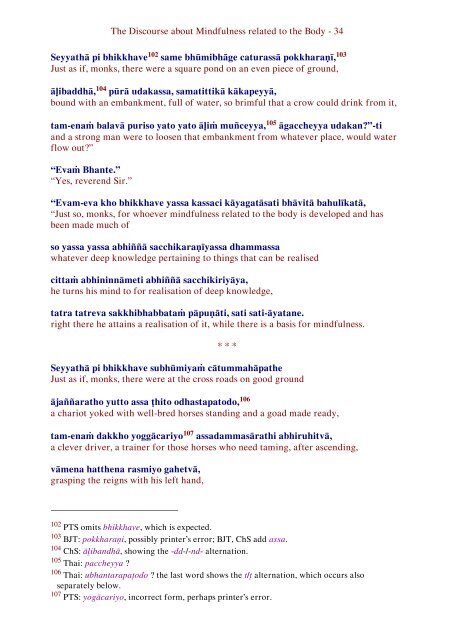Kayagatasatisuttam, the Discourse about Mindfulness related to the Body
A Pāli and English line by line (interlinear) version of this important discourse about the development of various meditations related to the body (together with extensive annotation).
A Pāli and English line by line (interlinear) version of this important discourse about the development of various meditations related to the body (together with extensive annotation).
Create successful ePaper yourself
Turn your PDF publications into a flip-book with our unique Google optimized e-Paper software.
The <strong>Discourse</strong> <strong>about</strong> <strong>Mindfulness</strong> <strong>related</strong> <strong>to</strong> <strong>the</strong> <strong>Body</strong> - 34<br />
Seyyathā pi bhikkhave 102 same bhūmibhāge caturassā pokkharaṇī, 103<br />
Just as if, monks, <strong>the</strong>re were a square pond on an even piece of ground,<br />
āḷibaddhā, 104 pūrā udakassa, samatittikā kākapeyyā,<br />
bound with an embankment, full of water, so brimful that a crow could drink from it,<br />
tam-enaṁ balavā puriso ya<strong>to</strong> ya<strong>to</strong> āḷiṁ muñceyya, 105 āgaccheyya udakan?”-ti<br />
and a strong man were <strong>to</strong> loosen that embankment from whatever place, would water<br />
flow out?”<br />
“Evaṁ Bhante.”<br />
“Yes, reverend Sir.”<br />
“Evam-eva kho bhikkhave yassa kassaci kāyagatāsati bhāvitā bahulīkatā,<br />
“Just so, monks, for whoever mindfulness <strong>related</strong> <strong>to</strong> <strong>the</strong> body is developed and has<br />
been made much of<br />
so yassa yassa abhiññā sacchikaraṇīyassa dhammassa<br />
whatever deep knowledge pertaining <strong>to</strong> things that can be realised<br />
cittaṁ abhininnāmeti abhiññā sacchikiriyāya,<br />
he turns his mind <strong>to</strong> for realisation of deep knowledge,<br />
tatra tatreva sakkhibhabbataṁ pāpuṇāti, sati sati-āyatane.<br />
right <strong>the</strong>re he attains a realisation of it, while <strong>the</strong>re is a basis for mindfulness.<br />
* * *<br />
Seyyathā pi bhikkhave subhūmiyaṁ cātummahāpa<strong>the</strong><br />
Just as if, monks, <strong>the</strong>re were at <strong>the</strong> cross roads on good ground<br />
ājaññaratho yut<strong>to</strong> assa ṭhi<strong>to</strong> odhastapa<strong>to</strong>do, 106<br />
a chariot yoked with well-bred horses standing and a goad made ready,<br />
tam-enaṁ dakkho yoggācariyo 107 assadammasārathi abhiruhitvā,<br />
a clever driver, a trainer for those horses who need taming, after ascending,<br />
vāmena hat<strong>the</strong>na rasmiyo gahetvā,<br />
grasping <strong>the</strong> reigns with his left hand,<br />
102 PTS omits bhikkhave, which is expected.<br />
103 BJT: pokkharaṇi, possibly printer’s error; BJT, ChS add assa.<br />
104 ChS: āḷibandhā, showing <strong>the</strong> -dd-/-nd- alternation.<br />
105 Thai: paccheyya ?<br />
106 Thai: ubhantarapaṭodo ? <strong>the</strong> last word shows <strong>the</strong> t/ṭ alternation, which occurs also<br />
separately below.<br />
107 PTS: yogācariyo, incorrect form, perhaps printer’s error.

















